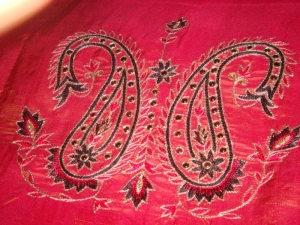Ari embroideries were being exported westward from Gujarat, in the west of India, towards the Persian Gulf and beyond. This type of decorated needlework appears in Iran and parts of the Middle East, especially Syria, where it is known as Ghabani work. It is also thought that ari work was introduced into Kashmir in the sixteenth century.
There are various types of ari work, depending on the type of ground material, the threads being used and the end product. In Kutch and Gujarat, for instance, ari work is used to decorate leather items such as bags, saddles and shoes. The ground material for ari embroidery is sometimes stretched on a frame and then worked. In other cases it is simply held in the hand, depending again on the type of ground material being used.
To produce ari work, a design is drawn or printed onto the ground material and then stitched, using the ari hook. One hand feeds the thread from the underside of the cloth while the other hand holds the hook on the top side. The hook is pushed through the material, it catches the thread and then brings it up through the ground material in the form of a small loop. This loop is then used to form the chain stitch. The process is repeated until the design is completed.
Ari embroidery may also include beads, sequins and spangles, which are kept on the obverse of the material (unlike the European version where they are often worked on the reverse side of the ground material). In general, it is much quicker to make a chain stitch using a hook than one worked with a conventional needle, hence the reason why it is widely used in commercial ateliers.
By the eighteenth century ari work had come to Europe and was quickly adopted, especially in France and Britain. In Europe it was called tambour work or tambour embroidery (after the French word tambour, meaning a drum), or sometimes Luneville embroidery after a French town that became famous in the nineteenth century for the production of this type of work. In Europe, the hook used for tambour work is normally called either a tambour hook or a Luneville hook.
Sources:
- DHAMIJA, Jasleen (2004). Asian Embroidery, New Delhi: Abhinav Publications, pp. 294 -296.
- MORRELL, Anne (1994). The Techniques of Indian Embroidery, London: B.T. Batsford Ltd., pp. 111-120.
Digital source of illustration (retrieved 9th July 2016).
GVE

